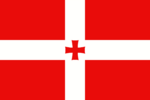Samuria

|
The Samurian Republic ხალხეთის რესპუბლიკა (Samt) Republica Samurieʃ (Romanish) Samturi Cumhuriyeti (Turquese) Republika e Samurit (Malësorian) Самтуртәи Аҳәынҭқарра (Tsarien) Capital: Tebari
Population: 3,894,102 (2024) Motto: ერთიანობა (United) Anthem: ოთხი ქვეყანა (The Four Countries) |
Loading map... |
Samuria (or Samturi) is a country in West Uletha, bordering Malesoria to the west, Livadia to the north and Kartlegia to the east. Samuria also borders Antharia via the Lake of Sens. Samuria covers an area of 17350.77 km² (6699.17 sq mi). It has a population of 3.9 million, out of which, almost a third of live in the city of Kldovani. The capital city of Samuria is Tebari, with a population of around 300,000.
Samuria has been inhabited since prehistory, hosting various tribes including the Tsarien and Dzvelian. Samuria is known for having one of the oldest textile and winemaking industries. The classical era saw the emerging of the two main Samt kingdoms; Tsakareti and Mteria, that formed the nucleus of modern Samuria. In early 13th century, the Samti's adopted Christicism, which partly contibuted to the unification of the Kingdom of the Samts. Samuria reached it's golden age during the 1400's, under the reign of King Solomon II and Queen Laura I. Beginning of 16th century, the kingdom declined after an invasion by the Romanish, and in the 19th century after an invasion by the Demirhani.
In 1883, the Kingdom of the Samts, or Kingdom of Samuria was re-declared, and reigned as monarchy until the year 1932, when the monarchy was abolished. Now, Samuria is a constitutional parliamentary republic, where the president, David Samtveli holds a rather ceremonial role. The Republic is apart of the Association of South Ulethan Nations, after joining not long after the monarchy was abolished. The same join date was for Samuria joining the AN.
Etymology
The international name Samuria derives from the native name Samturi. It is believed that the name Samturi essentialy means "Land south of the Tur", "Tur" being the Turcov mountains. [1] Another version is that Tur is an ancient paganic god, and his believers were the ancient Tsarien tribes, that lived in the Turcov mountain range. [2][3]
The first recording of the name Samuria was found in the "Samti Chronicles", which were written by David of Qvelaze.
The name has stayed unchanged since 1832. [4]
History
Prehistory
The oldest traces of archaic humans in what is now Samuria date from approximately 1.3 million years ago in the form of the Dmanisi hominins, a sub-species of Homo erectus representing one of the oldest-known hominin fossils in Uletha. [5] Buffered by the Turcov Mountains and the Sens Lake ecosystem, the area served as a refugium during the last glacial epoch. [6] The first continuous settlements date back to the Mesolithic period on the Sens Lake coast, close to around 150,000 years ago. During the Upper Mesolithic, settlements formed in the middle Samti region, where the plains are met with a hilly area, perfect for agriculture and settling. Most of the ancient population lived near the rivers Dasakhlda and Konpluksi. [7]
Earliest signs of agriculture date back to the 5th millenium BCE, especially in southern Samuria, where the hills and plains provide perfect places to grow vines and other agro-foods. During the 4th millenium BCE, the Dasakhlda and Konpluksi basins became more steadily populated, reaching a total population of about 250,000. [8][7]
Early history
The classical period saw the rise of many states in what is now Samuria, [9] including Dasa in eastern Samuria, where Hellenic mythology located the Golden fleece.
Hellanesian migration flows
The two Kingdoms
Unification
Golden age and Division
Within the Romanish and Demirhan
Independence years
2007 Samti-Surian border conflict
Geography
Demographics
Notes
- ↑ ეროვნული ისტორიული არქივი - 1982
- ↑ ყველაფერი სამტის ტომების შესახებ - 2003; pg.203-205
- ↑ ყველაფერი სამტის ტომების შესახებ - 2003; pg. 223-225
- ↑ Etymology of Samuria and the Sens countries (Ingerish) - 1966
- ↑ Archives mondiales - 1982; pg. 432
- ↑ Archives mondiales - 1982; pg. 433
- ↑ 7.0 7.1 HIoS - 2017
- ↑ სამტურის ისტორია
- ↑ HIoS - 2019 release
